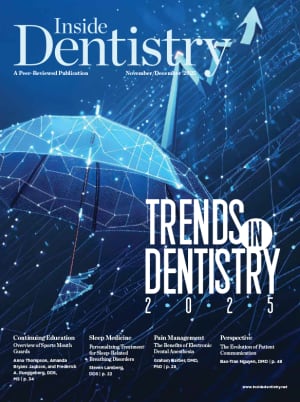Demystifying Modern Indirect Restorative Materials
Simplified categorization aids complex decision-making for nuanced material selection
When I was a first-year dental student back in the late 90s, I sat in my dental materials class over-whelmed by the complexity of the subject. However, looking back, this topic was actually relatively simple. There were two primary choices for posterior restorations-porcelain-fused-to metal or gold-plus a few additional options for anterior restorations. Fast-forward 25 years, and the landscape has transformed dramatically. Today's younger dentists face a daunting array of indirect re-storative materials that make the decision-making process more complex than ever. To simplify things for my students, I categorize indirect restorative materials into three categories: true ceramics, hybrid ceramics, and resins.
The true ceramics category includes glass ceramics and zirconia materials, which despite their differences, possess a crystalline structure. Although these materials vary in composition, strength, and esthetics, they can be luted or bonded and have an excellent clinical track record. Lithium disilicate, for example, has demonstrated a 16-year success rate of approximately 95%. True ceramics are the preferred choice for full-coverage restorations and large onlays because of their superior mechanical properties. When selecting materials in this category, many dentists prioritize strength, but that approach can be like trying to fit a square peg into holes of all different shapes. Trying to simplify material selection to this extent can be doing our patients a disservice. Understanding the nuances of each material's properties enables the selection of one with an optimal balance between durability and esthetics.
The next category, hybrid ceramics, is where things get complicated. According to the American Dental Association's Glossary of Dental Clinical Terms, a material qualifies as a ceramic if its ceramic filler content exceeds 50% by weight. However, many so-called hybrid ceramics are compositionally closer to direct composites than to true ceramics. In essence, they are resin-based materials with either ceramic particles or matrices. Nonetheless, manufacturers market these materials as ceramics, which has led to confusion among some clinicians and perhaps set an unrealistic benchmark for clinical durability. Although hybrid ceramics generally fall short of true ceramics in wear resistance and flexural strength, their advantages lie in single-visit convenience and their ability to be used for conservative partial coverage restorations. Despite their limitations, they remain a viable option for many clinicians, including myself, particularly when efficiency and minimal tooth reduction are priorities.
The third category is resin materials. Resin materials resemble hybrid ceramics but contain less than 50% ceramic filler by weight. Although they are weaker than hybrid ceramics, they offer an advantageous modulus of elasticity that makes them more flexible and less brittle. Esthetically, they are simple to polish, and if necessary, they can be repaired intraorally. However, these materials generally exhibit relatively poor wear resistance when placed in function. So, why use resin materials at all? The answer lies in the revolution of 3D printing. For example, a full arch of temporary restorations can be 3D printed in less than 30 minutes for approximately $30. However, when it comes to definitive restorations, better options exist.
The world of indirect restorative materials has expanded dramatically during the past 2 decades, offering a range of choices that offer varying degrees of strength, esthetics, and convenience for different applications. True ceramics remain the gold standard for longevity, hybrid ceramics provide a middle ground for efficiency, and resins are reshaping how we approach temporary restorations. For today's dentists, understanding the nuances of these materials is essential to delivering restorations that achieve both functional and esthetic success.
About the Author
Anthony Mennito, DMD, is a private practice dentist at Expertise Dental in Mt. Pleasant, South Carolina, as well as an adjunct faculty member at the MUSC College of Dental Medicine in Charleston, South Carolina.
